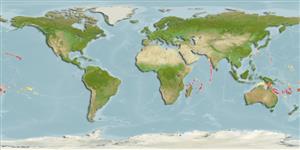Teleostei (teleosts) >
Kurtiformes (Nurseryfishes, cardinalfishes.) >
Apogonidae (Cardinalfishes) > Apogoninae
Etymology: Lachneratus: Greek, lachne, -es = more covered with hair than other (Ref. 45335).
Eponymy: Dr Ernest Albert Lachner (1916–1996) was an American ichthyologist and biologist who was Curator of Fishes, Smithsonian National Museum of Natural History (1949–1983) retiring as Curator Emeritus. [...] (Ref. 128868), visit book page.
Environment: milieu / climate zone / depth range / distribution range
Ecology
Marine; benthopelagic; depth range 3 - 104 m (Ref. 8908). Tropical
Eastern Pacific: Hawaiian Islands westward into the Indian Ocean.
Size / Weight / Age
Maturity: Lm ? range ? - ? cm
Max length : 7.4 cm SL male/unsexed; (Ref. 8908)
Found in or near caves and crevices (Ref. 58302).
Life cycle and mating behavior
Maturity | Reproduction | Spawning | Eggs | Fecundity | Larvae
Distinct pairing during courtship and spawning (Ref. 205).
Fraser, T.H. and P.J. Struhsaker, 1991. A new genus and species of cardinalfish (Apogonidae) from the Indo-West Pacific, with a key to apogonine genera. Copeia 1991(3):718-722. (Ref. 8908)
IUCN Red List Status (Ref. 130435: Version 2024-1)
Threat to humans
Harmless
Human uses
Tools
Special reports
Download XML
Internet sources
Estimates based on models
Preferred temperature (Ref.
123201): 24.3 - 27.8, mean 26.2 °C (based on 86 cells).
Phylogenetic diversity index (Ref.
82804): PD
50 = 1.0000 [Uniqueness, from 0.5 = low to 2.0 = high].
Bayesian length-weight: a=0.01096 (0.00509 - 0.02362), b=3.09 (2.91 - 3.27), in cm total length, based on LWR estimates for this (Sub)family-body shape (Ref.
93245).
Trophic level (Ref.
69278): 3.5 ±0.5 se; based on size and trophs of closest relatives
Resilience (Ref.
120179): High, minimum population doubling time less than 15 months (Preliminary K or Fecundity.).
Fishing Vulnerability (Ref.
59153): Low vulnerability (10 of 100).
